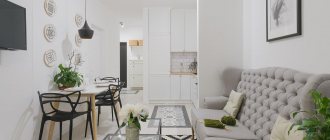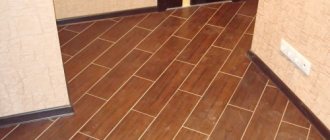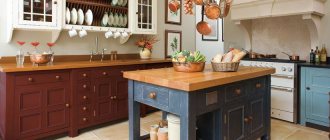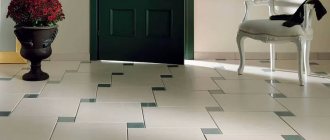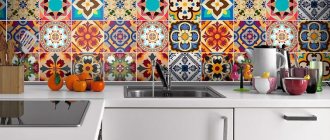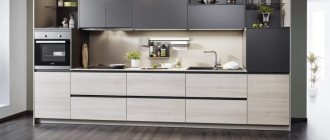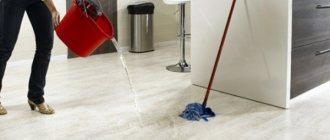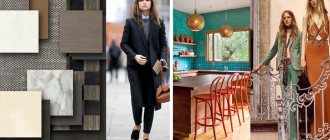What flooring to choose for the kitchen - this question arises for all homeowners who decide to carry out renovation work in this room. It must be said that the task of choosing is by no means an easy one, since today the assortment of construction stores offers such an abundance of different materials that, without information about them, you can easily get lost. Therefore, it makes sense to further consider the most popular floor coverings for the kitchen and take a closer look at their characteristics.
Flooring for the kitchen what to choose
Well, first you need to decide on the requirements that the floor covering in the kitchen must meet.
Tile
The most popular and sought after option is floor tiles. Its main advantages: low cost and ease of installation. The tiles are not afraid of water. And its huge selection - in colors, patterns and sizes - will allow you to create an original kitchen interior. You can combine tiles of different tones of the same color to create an interesting visual effect.
1/2
2/2
Coliseumgres Siena Bianco and Siena Grigio tiles
But the tiles have good heat transfer, so to make it comfortable to cook and walk barefoot in the kitchen, they install a heated floor.
Photo:
Senegal sand porcelain tiles
RUB 919.2*
Buy
*Price may change
Warm floor in the kitchen
Heated floors in the kitchen will allow you to comfortably walk around this room even in the cold season. This is especially true if you have ceramic tiles laid, the apartment is located on the first floor exactly above the basement, or the heating system operates at an average level. They install both electric and water heated floors.
Electric heated floors can be:
- cable - based on a two-core shielded cable, poured into a cement screed, ideal for tiles;
- film - based on a carbon film with copper and carbon fiber, very economical and loses less heat, optimal for installation under linoleum, laminate and parquet, and does not require screed;
- rod - infrared, is a mesh with intersecting carbon and copper elements, tile-like, universal and durable.
The installation of floor heating systems should be trusted to specialists in order to avoid subsequent operational issues. Be prepared to pay many times more for electricity. But this is quite a worthy exchange for comfort, isn’t it?
In private homes, water-heated floors are often used, which are cheaper in cost. It works by circulating water in a structure, the key elements of which are a collector and a thermostat. The base also needs to be well prepared: leveled, insulated, and provided with a vapor barrier. Only then can you begin installing the heating elements - in increments of 25-30 cm. After all the pipes have been laid, all that remains is to connect them to a common manifold. Using a thermostat, you can set the desired temperature - and in this simple way achieve the optimal level of heat all year round.
Porcelain tiles
Porcelain tile has similar qualities to tile, but is much stronger and more likely to withstand the fall of a heavy object. In terms of decorativeness, like tiles, the coating offers many design options: the surface of porcelain stoneware can imitate wood, concrete, metal and other materials. An excellent solution is to use patterned and regular porcelain tiles at the same time.
If you find it difficult to choose between tiles and porcelain stoneware, choose the material that you like best in appearance - at home, they will cope equally well with their tasks.
Photo:
Rovigo edged 50.2*50.2 ceramic decor
RUB 716.4*
Buy
*Price may change
Combination of different textures
In a large room, the floor can be decorated using several options. To decorate the working area, tiles, porcelain stoneware, and linoleum are used; Wood and its imitations and cork are installed in the dining area. This will help to furnish the kitchen as warmly, beautifully, reliably and durable as possible.
Natural wood
Wooden flooring made from natural species is a very environmentally friendly, but at the same time expensive option. However, it is precisely this kind of floor that can create a rich and respectable room design: it goes well with wooden furniture, looks noble and at the same time stylish. But when used in the kitchen, it must be protected from moisture, because water has a detrimental effect on wood. To create an original interior, you can lay not straight, but wavy boards.
This floor design is quite suitable for chalet, Scandinavian, loft and even minimalist style interiors, since the floor itself serves as the decor of the room.
Photo:
Solid board Stenwood Oak rustic 400-2000×100
RUB 2,280*
Buy
*Price may change
About screed and insulation
When renovations are in full swing, the question of which coatings to choose is not the most pressing. Now the main thing is screeding and leveling the surface.
Before choosing the material from which the screed will be made, you need to think about what you will lay on top.
If it’s a tile, then it makes no difference what’s underneath and regular cement mortar will do. And if it is a laminate, then it is much better to make a gypsum screed using a plaster mixture. This floor will be much warmer and less moisture permeable.
Also, the thickness of the screed may depend on what type of insulation you choose.
And if you raised the screed high enough, then making wooden flooring is no longer very reasonable if your ceiling height is standard, that is, 2.5 meters. If you “steal” an extra 10 cm, this will significantly affect the visual perception of the room.
And if you are also planning a suspended ceiling, then this will not be good at all. Now let's get closer to the topic and talk about specific coatings.
Parquet
Parquet is lighter than solid boards, since natural wood is only in the top outer layer. The rest of the structure consists of cross bars with grooves for easy and quick connection. In addition, the parquet initially has a protective varnish coating, which allows it to be used in the kitchen.
1/2
2/2
Bauwerk Black Limited parquet and Smoked Oak
If it is possible to use parquet in the interior, this is certainly the best option, since the joints of two materials, such as laminate and tiles, always create some visual tension.
Photo:
Verona Oak
RUB 3,550*
Buy
*Price may change
Main characteristics of popular floor coverings
Now, knowing all the qualities that a kitchen flooring should have, we can consider the advantages of the most popular ones.
Ceramic tile
Ceramic tiles today are one of the most popular floor coverings for rooms such as the bathroom, hallway and kitchen. If this material is laid in the kitchen of a private house or above an unheated room, then a “warm floor” system is most often installed underneath it, since this material itself is cold, but has high thermal conductivity.
Ceramic tiles have been and remain the leader in popularity among other kitchen floor coverings
If you decide to use ceramic tiles for your kitchen floor, you should familiarize yourself with some of its basic characteristics. They will help you decide on the right choice of this material.
- Wear resistance
The wear resistance of ceramic tiles is determined by five categories, and depends on the degree of its selectability. This indicator has the abbreviation PEI:
- PEI I - tiles bearing this marking are intended exclusively for wall decoration.
- PEI II - a similar category of material is used for the floors of bedrooms and bathrooms. It is recommended to walk on this surface only in soft-soled shoes or barefoot.
- PEI III - material of this category can be laid in any room except the hallway, since it does not have sufficient resistance to abrasive wear.
- PEI IV - tiles with this marking are used to cover floors in public buildings, as they have a high level of wear resistance. Therefore, this material option is well suited for the flooring of kitchens and hallways.
- PEI V - this category has the highest degree of wear resistance, and is usually purchased for installation in places with high traffic levels, for example, for shops. Therefore, this option is also suitable for the hallway and kitchen. True, the feasibility seems questionable: the strength characteristics of such a coating are excessive for apartment conditions, and the price is significantly higher.
Based on the above arguments, we can conclude that the best option for a kitchen floor would be tiles with a wear resistance category of PEI IV, or, in extreme cases, PEI III.
- Chemical resistance
The resistance of ceramic tiles to chemical influences is indicated by the letter symbols: AA, A, B, C and D. The material designated by the letters A and AA has maximum resistance to aggressive chemicals. It is these categories, as well as tile B, that are well suited for installation in kitchen areas.
Pay attention to the category of tiles for moisture absorption
- Moisture resistance
The level of moisture resistance depends on the tile manufacturing method - pressing (B) and extrusion (A). Tiles made by pressing have a high density and strength, while material produced using extrusion technology has a more porous structure.
Ceramic finishing material is divided into three categories, each of which has an additional letter designation, and is characterized by its own moisture absorption parameters, in% by weight:
— AI and VI are the most moisture-resistant ceramic tiles. The moisture absorption of its surface is only 3%.
- AIIa and BIIa - these categories absorb from 6% to 10% of moisture from the total mass and have good frost resistance;
— AIII and BIII are the least moisture-resistant tiles, since their moisture absorption exceeds 10%.
Tiles with the number I in the category designation are intended for tiling bathrooms and swimming pools. If desired, it can also be used in the kitchen.
Category II is often used for external finishing work.
Category III is used for finishing floors and walls exclusively indoors with normal humidity levels. For the kitchen this is far from the best option.
The level of moisture resistance directly affects the cost of the tile - the higher the category, the higher the price set for it.
- Tile surface
The surface of the tile can be glossy, matte, embossed, rough and polished. The best option for the kitchen would be embossed, rough, and, in extreme cases, matte tiles - these options are practically non-slippery and safe for walking even on a slightly damp surface. However, you should not choose tiles with too deep a relief, as dirty deposits will become clogged in its recesses, which will be difficult to clean.
The slipperiness of ceramic tiles is indicated by the coefficient of friction and special attention should be paid to this parameter, since the safety of being in the kitchen depends on it. The friction coefficient is divided into 4 categories:
Kitchen-safe rough tiles
— The safest tile has a digital designation of 0.75.
— Conditionally safe material is designated 0.39÷0.74.
— Dangerous, that is, quite slippery, has a friction coefficient from 0.22 to 0.39.
— Very slippery, its coefficient is no less than 0.19. Such tiles cannot be laid on the floor.
From these parameters we can conclude that rough or embossed tiles have the maximum safe coefficient of friction, while smooth and glazed tiles have a lower value and are not suitable for floor coverings.
- Grade of ceramic tiles
In addition to the above characteristics, you should pay attention to the type of tile - this parameter indicates the amount of possible defects in each of the packages - mismatch in size, linearity of material, etc. There are three types of ceramic, each of them is usually marked with its own color:
— I grade (red) — has no more than 5% conditionally defective products;
— II grade (blue) — has up to 20% defective material;
- III grade (green) - this is the lowest quality and inexpensive product.
There are other characteristics, and there are quite a lot of them, but above are the main ones that you need to pay special attention to. In order not to get confused in the parameters when going to the store, you should write down the necessary data and, based on them, select the desired sample.
- Decorativeness
A little needs to be said about the decorative qualities of ceramic tiles, since the overall appearance of the kitchen interior will depend on this.
Nowadays, the commercial assortment offers a very wide variety of finishing floor tiles of various colors and patterns, which can imitate natural materials, or simply be decorated with interesting patterns and ornaments.
A well-chosen combination of several types of ceramic tiles looks very original.
The tiles can have a raised pattern, giving the floor a richer “carpet” look. When choosing a finishing material according to this criterion, it is necessary to take into account its harmony in color, texture and relief with the design of the rest of the interior.
Mosaic laying of ceramic tiles on the floor can visually expand a cramped space
It is important to choose the right tiles in shape and size, since this criterion will determine whether the kitchen space will visually expand or whether it will look smaller than it actually is. Today you can find material on sale in a wide variety of configurations and sizes - tiles can have geometrically regular and patterned shapes, so if you wish, you can bring any ideas and design ideas to life. In addition to the tile itself, it is always possible to purchase embossed borders or “carpet” elements to go with it.
Linoleum for the kitchen
One of the most practiced solutions is to cover the kitchen floor with high-quality linoleum
. Despite the abundance of new materials, linoleum can still be called the most popular floor covering not only for the kitchen, but also for any room in the apartment. The main thing is to choose the one that is ideal for a particular room.
Types of linoleum
In flooring stores you can find two main types of linoleum - natural and made from synthetic raw materials. Each of them is suitable for different rooms, and has its own advantages and disadvantages.
liquid linoleum
Synthetic based linoleum
The most popular is linoleum made from synthetic raw materials, since it is affordable even for a family with an average income. It is quite durable - high-quality artificial linoleum, subject to the rules of operation and care, will last 12–15 years.
Artificial linoleum is made from various materials, but for use in residential buildings, the material most often purchased is polyvinyl chloride, which, according to experts, is the safest for humans, with the exception of some cases of individual intolerance.
Scheme of the structure of multilayer PVC linoleum
Linoleum intended for residential premises is a multilayer structure:
- The bottom layer is the base of the material.
- Elastic backing made of foamed polyvinyl chloride.
- Reinforcing fiberglass layer that gives the material strength.
- Another layer of polyvinyl chloride, which has a smaller thickness.
- A layer consisting of a decorative film with a pattern applied to it.
- A transparent layer that increases the wear resistance of the material.
- Top protective film.
Multilayer linoleum is referred to as heterogeneous.
If the material consists of one layer (not counting the upper protective film), then it is called homogeneous. Such material can be either very thin or have a thickness of 10–15 mm. Homogeneous linoleum is a high-quality material, but it does not have a variety of decorative textures - it is usually monochrome, sometimes “decorated” with splashes of color.
Homogeneous linoleum, as a rule, is monochromatic, only with splashes of color.
The most common PVC linoleum has almost all of the above requirements for kitchen flooring:
- The material is water resistant.
- Easy to clean.
- Resistant to abrasion and mechanical stress.
- It is quite durable - its service life is on average 12÷15 years.
- Affordable.
- It is easy to lay linoleum yourself, as it is quite simple to install.
- This flooring is available in a very wide range of design solutions. Linoleum can imitate parquet, ceramic tiles, cork or plank flooring, as well as many other ornamental or clear geometric patterns.
- Some relief patterns are not only decorative, but also an anti-slip element of the linoleum covering.
Artificial linoleum comes in three classes - commercial, semi-commercial and household. For flooring in apartment premises, it is necessary to choose only the household version of the material, which is classified as 21, 22 and 23 classes and has a thickness of 3÷5 mm.
The number “2” in front indicates that the material is intended for living space, and the second number shows the resistance of linoleum to stress. For example, “1” is low resistance, and “3” is the highest abrasion resistance for a household version of such a floor covering.
Classification table for household linoleum.
| Linoleum class | Symbols of class placed on packaging | Permissible load level | Load intensity | Optimal places to use the material |
| 21 | short | Rooms with low traffic intensity or areas that are rarely visited. | Storage room and bedroom. | |
| 22 | average | Premises with moderate intensity of human movement. | Living room, dining room, office and kitchen. | |
| 23 | high | Premises with traditionally high intensity of people movement | Kitchen and hallway. |
From this table it can be seen that for the kitchen, in principle, 22 is suitable, but class 23 flooring would be even better.
Semi-commercial and commercial classes are more durable, but they have a higher content of components that are not harmless to humans, and their use in domestic conditions is not recommended.
Linoleum PVC tiles
Linoleum is produced not only in the usual rolls, but also in other forms that are easier to install.
laminate for kitchen
Laying flexible linoleum PVC tiles
You can purchase PVC linoleum in square or rectangular tiles - these materials can imitate ceramic coating, parquet or laminate. Installing such tiles is quite simple, since they usually have an adhesive layer on the back side, covered with a protective backing. However, in order for the installation process to be easy and the resulting coating to be of high quality, the base under it must be almost perfectly flat and smooth.
Linoleum in this form of release has its own advantages and disadvantages, which you also need to know about before choosing it.
The positive qualities of PVC tiles include both the ease of laying the material and the ability to replace areas damaged during operation. There is no need to remove the entire coating or cut out a separate area of it and look for a suitable replacement. To dismantle the area that requires replacement, you simply need to remove the damaged tiles and fix new ones in their place. Based on this circumstance, it is recommended that when purchasing a covering, purchase it with a reserve, that is, take 5-10 tiles more than is actually required for the kitchen floor area. They are inexpensive, and such a reserve will not “hit your pocket.”
One of the positive qualities is that all kinds of designs and compositions can be created from PVC tiles of various colors, so the interior of the kitchen can be made absolutely exclusive. A wide range of colors of monochromatic material, as well as those with ornamental patterns, allows you to choose the desired decorative option for a specific interior.
An obvious drawback of tiled linoleum is that there are too many seams, which is not very good for covering a kitchen floor, since the humidity in this room is high due to fumes of various origins - this can lead to gradual separation of the material from the base. If you still want to use tiled linoleum to cover the kitchen floor, then you need to prepare the base for it very well. It must be perfectly flat and well-primed.
Natural linoleum (marmoleum)
Natural linoleum, also known as marmoleum, is made from cork and lime powder, linseed oil and wood flour with the addition of natural coloring pigments to the overall mixture. The basis for this type of material is flax or jute fibers or non-woven materials.
Natural linoleum (marmoleum) is designed for many years of use
The technological principles for the production of this natural floor covering have not changed for many decades - only the designs have been modernized in accordance with new interior styles. Marmoleum has a large number of positive qualities that meet the requirements for kitchen flooring. These include:
- Durability – the coating lasts from 20 to 45 years.
- Eco-friendly coating.
- Resistant to ultraviolet radiation, as well as to aggressive chemicals and detergents.
- High wear resistance.
- Additional sound and heat insulation of the floor.
- Flaxseed oil, which is part of marmoleum, gives the material antiseptic properties.
- The natural material is non-hygroscopic, easy to clean, and does not absorb grease and dirt.
Marmoleum is most often produced in calm pastel colors, and this gives the interior coziness and stability.
An excellent solution for those who love calm pastel colors for kitchen decoration
The main disadvantage of the material is its high cost, so synthetic linoleum is often preferred to it. In addition, the material is demanding on the base, and it is better to entrust its installation to a specialist, since it is laid only with glue, applying it over the entire area of the kitchen.
"Liquid linoleum"
Although this material is included in the linoleum section, it, by and large, is not such.
“Liquid linoleum” is a common name for decorative polymer self-leveling floors
“Liquid linoleum” is sometimes called a self-leveling polymer floor. Despite the fairly high price and the difficulty of doing it yourself, this coating is becoming increasingly popular, as it has a considerable number of advantages that fully meet the criteria discussed above.
- “Liquid linoleum” has the longest service life of all types of synthetic flooring materials.
- Such a coating can be created based on your own sketches. The variety of possible patterns cannot be compared with any of all existing floor coverings.
- The floor surface is characterized by excellent water resistance and non-hygroscopicity. Moreover, the poured polymer layer also becomes excellent waterproofing.
- In the future, if you decide to renovate the kitchen and change its design, the self-leveling floor will not have to be dismantled, since it itself creates a perfectly flat and smooth base, which is suitable for laying any other covering.
- This type of coating is made of polyurethane or epoxy resin, therefore it is an environmentally friendly, harmless, biologically resistant material.
- “Liquid linoleum” has the ability to visually expand space, as it has the effect of a 3D pattern.
The disadvantage of self-leveling flooring is not only its relatively high cost, but also the fact that you will have to invite a specialist to install it. The pouring process is quite complex, and in order for the coating to turn out to be of high quality, it is necessary to have relevant experience.
How to choose the right quality linoleum?
When choosing linoleum for the kitchen, you need to pay attention to the following parameters that indicate the quality of the material:
- A conscientious manufacturer always leaves the contact information of his company on the packaging. This factor indicates that he is confident in the quality of his products.
- At the buyer's request, the sales consultant is obliged to provide a quality certificate for the product.
- The material should not have an unpleasant pungent odor.
- There should be no damage or manufacturing defects on both the front and inner surfaces.
The lines of the drawing should be clear, not blurry. “Floating” outlines indicate a violation of production technology
- The pattern on the coating must be clear, and its pitch must also be observed.
- The surface of linoleum should be uniform - embossed or smooth, depending on the chosen type. If the relief or, conversely, the smoothness is broken in places, then the material is considered defective.
- If you purchase narrow linoleum and plan to lay it in two sheets that will fit together, then it is very important to ensure that both rolls are from the same batch, otherwise they may differ in shade. The production batch number must be found on the packaging.
What linoleum patterns are best to choose for the kitchen?
As mentioned above, during the cooking process it is very difficult to avoid fumes and contamination of the floor covering. Therefore, it is better not to choose plain linoleum in light shades for this room, on which even small stains that fall on it will immediately give an untidy look to the entire room. It is recommended to purchase a coating of such a color that it can hide minor dirt, otherwise you will have to clean it after each cooking.
Linoleum in the kitchen should not be too light - imitation wood or natural stone would probably be the best option
Linoleum is well suited for a kitchen space, having a watercolor painting that is found on the cut texture of wood and stone of different types. Such designs imitate the relief forms of natural materials, and may well hide minor stains, the removal of which can be postponed until a thorough cleaning of the kitchen.
Using the pattern and color of linoleum, you can visually expand or narrow the room, lengthen or shorten it.
kitchen tiles
The correctly chosen direction of laying the linoleum pattern can visually expand or lengthen the kitchen space
For example, if linoleum imitates a solid board or rectangular laminate slats and they are laid across a narrow kitchen, then the room will appear visually wider. If you need to create an elongation effect, then you should install such material along the room.
Squares of contrasting colors applied to the linoleum in a checkerboard pattern visually increase the space. You can achieve this effect yourself by using linoleum tiles to cover the floor.
Laminate for the kitchen
Laminate on a kitchen floor is beautiful, but requires special care and caution during operation.
Laminate is a relatively new floor covering, but has already become quite popular due to its ease of installation, affordable price and aesthetic appearance. However, it should be noted that this material is still not the best option for a kitchen space, since if the slats are poorly joined and moisture gets between them, the laminate can deform and delaminate. Of course, there are coatings of different quality and grade, but even if water is spilled on a moisture-resistant laminate, it must be quickly removed.
Even on a moisture-resistant laminated coating, you still shouldn’t leave puddles for a long time.
Such flooring can be given a variety of designs - it can be an imitation of solid wood, a cut of stone, or the texture of leather. In addition, the laminate can also be decorated with geometric patterns of varying degrees of complexity.
Laminate with imitation of decorative parquet
Some types of laminate can be used for laying over underfloor heating systems. The packaging of such material must indicate that the material is suitable for such use.
How to choose a laminate?
This material also has an appropriate classification both in terms of wear resistance and coating installation technology. The details of choosing a laminate for your home are well outlined in a special publication on our portal.
Wooden floor in the kitchen
Wooden floors can be called traditional, since previously wood was the most popular and almost the only available material for flooring. Today, wooden floors can be found quite rarely in modern apartments - materials that only imitate wood are more often used. In order for a wooden floor to last for a long time, it needs constant care, for which, as always, there is not enough time.
Wooden floors in the kitchen require special care
If a wooden covering is chosen, for example, for laying on a concrete screed, then the material must be properly treated with various water-repellent impregnations, and after installation it must be coated with a special varnish. After such treatment, the floor surface will acquire all the qualities necessary for a kitchen space - moisture resistance, hygiene, safety, high wear resistance, decorativeness, as well as low thermal conductivity, which means the floor will be warm even without heating.
But wood that has not received proper treatment will quickly become unusable, since it is sensitive to moisture and the aggressive environment of chemical compositions of detergents.
Considering that wood is a relatively light material, a covering from it can be made in an apartment in a multi-storey building - it will not increase the load on the interfloor ceiling.
For the floor in the kitchen, high-quality tongue-and-groove boards are chosen from wood species such as larch, ash or even oak. The thickness of the boards depends on the height to which they will be raised from the concrete base, but this parameter in any case should not be less than 20 mm. The width of the boards is usually from 90 to 150 mm, and their length will depend on the intended laying pattern.
Plank floor laid staggered
To ensure that the coating is perfectly even, after laying it, the boards are scraped using a special machine. For this purpose, you will most likely have to call a specialist.
A nice, but very controversial option for the kitchen is parquet flooring
Wooden flooring, in addition to solid wood, also includes parquet boards and parquet. If you decide to install only wood in your kitchen, then it is better to give preference to parquet or parquet boards made from deciduous trees that have high wear resistance and sufficient hardness. But when choosing this material, you should remember that it must also be treated with compounds that will protect it from moisture, rapid abrasion and mechanical stress.
Today on sale you can find parquet or parquet boards of different shades and textured patterns, so this coating can be chosen to suit every taste.
Is it difficult to lay a wooden floor yourself?
If you suddenly decide to make a plank covering in the kitchen or in another room, then you should familiarize yourself with the technological recommendations in this regard in advance. Details of laying a wooden floor with your own hands are in a special publication on our portal.
Cork flooring in the kitchen
Cork has not yet become widespread due to the high cost of the material and the considerable complexity of high-quality installation. However, it is absolutely undeniable that it has a lot of advantages that can even solve some problems.
An excellent, albeit very expensive choice is natural cork coating.
Cork is well suited for covering kitchen floors. This material is warm and pleasant to the touch, environmentally friendly, and does not emit any harmful fumes. Cork is waterproof, it does not rot or deform from moisture, does not attract dust, and is also a good heat and sound insulator.
Despite all the listed positive qualities of this coating, it also has its disadvantages. Thus, a cork floor can be damaged if hot grease or heavy or sharp objects fall on it. Therefore, for the kitchen it is recommended to choose cork material with a special wax impregnation and an external protective varnish coating.
To cover the floor in the kitchen, it is better to purchase cork material, sold in rolls and glued to the base. Cork flooring made from MDF in the form of slabs (like a laminated board) is less suitable for the kitchen, since moisture can penetrate between them.
There are other floor coverings for the kitchen, less common, but probably due to the fact that there is not enough information about them yet. An example is vinyl panels equipped with locking joints. Laying such panels is an accessible process that any owner can quickly master.
Video: installing panel vinyl flooring
Laminate
A more economical option compared to natural wood is laminate. It is less environmentally friendly, but it is scratch resistant and easier to install. But the kitchen coating requires moisture-resistant treatment. The material imitates any wood surface, so its aesthetic qualities are not much inferior to wood.
Still, it should only be used in the kitchen if you cook infrequently or very carefully so that splashes of moisture and grease do not fall on the floor.
Photo: i0.wp.com
LAMINATE EUROHOME ART 12/33 4V OAK EGGSHELL GT 1.48 M2
750 rub.*
Buy
*Price may change
Criteria for choosing kitchen flooring
Since the kitchen is one of the most visited rooms in an apartment or house, it can easily be considered an area of high intensity of human movement. In addition, when choosing a material, you need to take into account factors such as temperature changes, high humidity and the presence of a large number of fumes of various origins, which, one way or another, will affect all the finishing materials of this room. Therefore, the floor covering must have the following qualities:
- Moisture resistance of the material . In the kitchen, the floor covering cannot avoid exposure to moisture - this is not only evaporation and splashes during cooking and washing dishes, but also frequent washing of the floors.
Water on the kitchen floor is a completely common occurrence, and the coating should not be afraid of this.
In addition, water and sewer pipes pass through the kitchen, from which moisture also emanates, and this fact also cannot be ignored when choosing a floor covering.
- Low hygroscopicity . Not only will the material be inert to moisture, it must not absorb it, otherwise a favorable environment will be created under the coating for the appearance of colonies of microflora - mold and mildew. They will negatively affect not only the coating itself, but also the screed or wood laid underneath it.
- Impact resistance . The kitchen is a room in which there are a large number of different heavy dishes and other kitchen utensils, so there is always a risk of accidentally dropping one of them on the floor. Taking this into account, you need to choose a material that can withstand the impact of a cast iron frying pan or cauldron falling from a height of one meter.
- Hygiene. The floor covering should be easy to clean from dirty and greasy deposits and stains.
- Slipperiness of the material. For the above reasons, such as grease and water getting on the surface of the coating, it is necessary to take into account that these compounds should not easily spread across the floor and slide underfoot. Otherwise, this factor can lead to household injuries. The coating should not be perfectly smooth - a slightly rough surface is more suitable.
- Wear resistance. Since the process of cooking occurs every day in the kitchen, a greasy deposit may form on the floor covering, especially near a gas or electric stove, which is not so easy to remove. Therefore, quite often it is necessary to use brushes and abrasive powders to tidy up the floor. Taking this into account, it is necessary to choose a coating that can withstand such cleaning, or one that does not absorb or accumulate grease deposits.
- Abrasion resistance. The kitchen is a room frequently visited by all family members, but most of all, the hostess is in constant motion while preparing food. Therefore, the surface layer of the coating, as well as its decorative layer, must be resistant to abrasion.
- Foundation requirement. When choosing a coating, you need to take into account the fact that some of the materials must be laid or laid on a carefully prepared base in a special way.
Laying laminate flooring on top of a well-laid old linoleum
If there is no opportunity or desire to carry out such work, a coating is purchased that can be laid on the previously laid material, of course, if it is in good condition and securely fixed to the floor surface.
- Resistant to temperature changes. If you plan to install a “warm floor” system in the kitchen, then you need to choose a coating that can withstand temperature changes not only outside, but also from below. In addition, the material must have high thermal conductivity.
Sometimes a combination of two different materials is used
- Design decision. If you plan to divide the kitchen into zones, designating them with different flooring materials or different colors, then you need to think carefully about their connecting line, as well as compliance with all the requirements listed above. It should be noted that a material correctly selected in texture and color can visually expand the small space of a standard kitchen in a city apartment.
Cork
A natural material that will decorate any interior thanks to the abundance of colors and textures. Cheaper than natural wood, but with similar decorative qualities and environmental friendliness. For a kitchen, a cork floor coated with varnish would be an excellent solution, as it is easy to clean and is not afraid of stains. It will look most organic with wooden furniture, but cork can also be used in other styles, creating an unusual design.
In addition, cork is an excellent soundproofing material, which is important in modern new buildings.
Photo: thisoldhouse.com
Cork floor CorkArt Natural
RUB 2,240*
Buy
*Price may change
Combination
Deciding on a single floor covering for the kitchen can be difficult. By approaching the matter with a creative approach, you can combine several materials beautifully and practically. This will create a convenient, comfortable space. For example, the work area should be easy to clean. The tiles are very suitable in this regard. And in the dining area it will be more pleasant to feel parquet or laminate under your feet.
Combined floor
According to the advice of designers, if the kitchen is separate and small, it is better to use one material for the floor. There are no walls in the studio, and it is good to separate zones using different coatings.
There are many ways to combine materials. These can be the same color coating or different contrasting shades. When deciding to combine, you need to take into account all coating thicknesses so that there are no inconvenient thresholds at transitions and joints.
When it comes to combinations, the main thing is not to overdo it. There is no need for a store of finishing materials in the apartment. Natural materials and those that create a copy of them should not be combined. There are no coatings that are ideally suited to each other.
In general, the opinions of professionals differ on the issue of using several types of coatings in one room . Some people think that it is possible to create unique combinations. It will be very beautiful and convenient. Others argue that different tactile materials cause stress, so it’s better to stick to one type. Moreover, the industry is increasingly producing materials that meet all the increased requirements.
Decorating connections
Combination of tiles with laminate
Correctly designed joints of materials are an important point. There are special profiles for connection. They come in different colors. It won't be difficult to match the tone. The downside will be the resulting threshold.
You can use a strip of cork at the joint. If the shade does not match, it is carefully painted or covered with an L-shaped profile. And materials glued to the base do not form any thresholds at all.
You can show your imagination not only by combining different materials and their colors. The use of decorative elements , such as borders, mosaics and baseboards, allows you to beautifully decorate the kitchen, dividing zones.
Linoleum
Synthetic linoleum is an excellent option for the kitchen. It's cheap and very easy to install with your own hands. The material is wear-resistant, so it will last a long time. Modern linoleum with many different patterns - wood, tile or even abstract - will allow you to choose the coating to suit any interior style.
Today, linoleum is again gaining popularity: it has become more environmentally friendly; it is often chosen by those who have lost their favorite cup that fell on a hard tile surface. In addition, it does not require underfloor heating.
Photo:
Linoleum "Palermo" 32 class, 3 m
RUB 478*
Buy
*Price may change
Chipboard panels
If you are looking for the best flooring to install in the kitchen without going broke, then look at budget laminate flooring. Laminate is chipboard panels that have been pressed and glued with specially processed paper with a pattern.
A well-made laminate, with a wood pattern, is difficult to distinguish from a parquet board. Many models have recently begun to be covered with patterns of marble, ceramics, metals, and stones.
If the board is damaged, replacement is very simple. And it’s not difficult to care for the surface; you need to regularly sweep and wipe the floor without aggressive chemicals, because the pattern of the laminate can be damaged. If liquid is spilled, wipe it up immediately. If it remains on the panel for a long time, the chipboard will swell and a complete replacement will be needed.
Laminate is relatively warm and provides some noise insulation.
Terrazzo
A seamless mosaic (terrazzo) coating in the kitchen will help create an individual interior. This pattern of individual elements will become an original decoration of the room and will suit any style, depending on the color and texture. An interesting option is to use not a classic mosaic made of glass or ceramics, but to create, for example, a covering made of marble or stone.
An excellent solution for a country house, the size of the kitchen-living room allows you to enjoy the pattern of the stone and walk on it without taking off your summer shoes.
Photo: diespeker.co.uk
Terrazzo gray mosaic 14.7*14.7 ceramic decor
RUB 373.2*
Buy
*Price may change
The most beautiful kitchen floors in photos
An interesting selection of spectacular floors, which we have divided into two parts. Whoever has a kitchen will be more interested in this scale.
In a small kitchen
In the kitchen-living room
Summarizing
Provence style
The choice of kitchen flooring depends on:
- family composition
- host preferences
- general style of the room
- room size
- location of kitchen areas
But there are basic recommendations:
- Absolutely any material will last a long time when the kitchen is rarely used and there are no children or animals in the family
- If you have a small kitchen space where you constantly cook, there are pets, objects often fall and liquids spill, tiles, porcelain tiles or vinyl are the best choice
- The combination of materials is suitable for rooms with several combined zones
- In a compact space of up to 5 m2, it is advisable not to use multiple materials
- When combining, it is necessary to determine in advance whether additional insulation will be used under the coating. This will affect the height of the rough layer. A cork expansion joint in the color of the parquet will look good at the joints
- Playing with directions when laying , tiles, laminate, boards will add variety to the space and divide it among themselves
- When agonizing over choosing, for example, wood or tile, which is better, you don’t need to make sacrifices between aesthetics and practicality. Nowadays it’s easy to choose tiles, porcelain tiles or vinyl with a wooden texture
You can find the perfect coverings for your kitchen. You just need to carefully understand this issue. Recommendations from professionals will help you make the right decision.
Quartz vinyl
Vinyl flooring combines the best properties of modern finishing materials. From linoleum he got flexibility and elasticity, from natural stone - stability and strength, from laminate - simplicity and speed of installation. As a result of this symbiosis, a modern product for kitchen flooring was created with unique performance characteristics, varied designs and simple flooring technology.
Different names for vinyl tiles (quartz vinyl, waterproof, vinyl and stone laminate, LVT, WPS, SPS, Rigid, PVC tiles) are misleading and make it difficult to choose this type of flooring. This abundance of names is a consequence of a unique marketing approach that encourages increased interest and consumer demand for vinyl coverings. In fact, it is more correct to classify the material according to production technology, the methods of which determine the quality of the tile.
CPS technology
This vinyl covering is a stone-polymer composite. It consists of 70-80% natural material - calcium carbonate (chalk, limestone) and a binder - PVC. The tiles are similar to ceramic tiles, but have a durable polyurethane coating on top.
Inexpensive natural raw materials are used for production, so this material has a low price.
Pros:
- High rigidity of the product.
- Affordable price.
- Tolerates uneven floors well
- The material transmits heat well and is suitable for “warm” floors.
Minuses:
- Surface cold to the touch.
- The fragility of the locking joints, which creates difficulties during transportation and installation of the floor.
This type of tile is produced only in China. It is impossible to track what standards manufacturers follow and how this tile is produced.
WPS technology
Wood-polymer composite consists of a base consisting of calcium carbonate, wood flour and PVC.
Pros:
- Comfort when walking.
- The material is warm to the touch.
- Geometric rigidity, which simplifies the installation process.
Minuses:
- Under the influence of heavy objects, the tiles can be pressed.
- High price.
